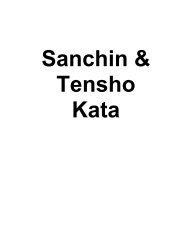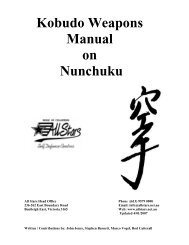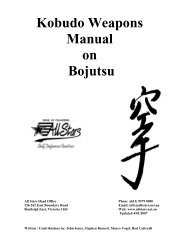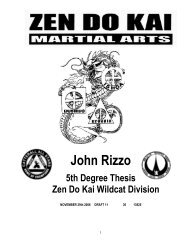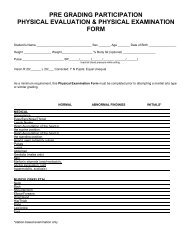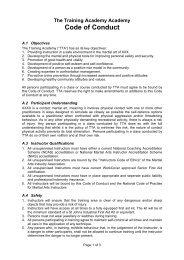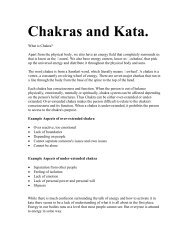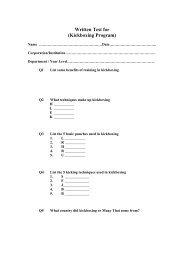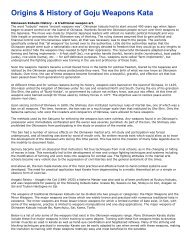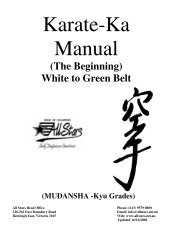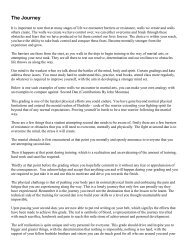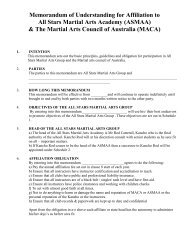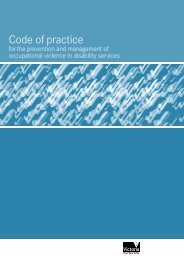Anatomy & Physiology Study.pdf - All Stars Self Defence Centres
Anatomy & Physiology Study.pdf - All Stars Self Defence Centres
Anatomy & Physiology Study.pdf - All Stars Self Defence Centres
You also want an ePaper? Increase the reach of your titles
YUMPU automatically turns print PDFs into web optimized ePapers that Google loves.
<strong>Anatomy</strong>The Respiratory SystemThe act of breathing in, removing oxygen from the air, and breathing out air containing increased amounts ofcarbon dioxide, is called respiration. Every time a breath is taken in, air is drawn through the mouth or noseand down the windpipe into the lungs. The windpipe branches into two main tubes before it enters the lungs,where it divides into many smaller tubes that branch out through the lung tissue. At the end of each tube is atiny air sac, which is surrounded by blood vessels. The blood in these vessels takes up oxygen, a gascontained in the air, and gives off a gas called carbon dioxide, which is a waste product of the process thatconverts food into energy. In breathing out, the air passes back through the same passages.The major components in the respiratory system include the:• Mouth and nose• Larynx (voice box)• Trachea (windpipe)• Bronchi (tubes that divide from the windpipe)• Alveoli (air sacs)• Rib cage• DiaphragmMechanics of BreathingFor air to enter the air passagesand the air sacs, the pressure inthe lung tissue must be lowerthan the air pressure outside thebody. To enable this to happen,the diaphragm moves down, alittle like a plunger in a syringe,and at the same time, the ribsand chest wall move out. Theresult is an increase in spaceinside the chest and a loweringof the pressure in the lung.Since this pressure is nowlower than air pressure, airflows through the air passages(inspiration). To exhale(expiration), the pressure mustrise. This is brought about bythe diaphragm moving up andthe ribs and chest wall movingin. The action of breathing inand out resembles the action of a set of bellows.
The Circulatory SystemThe circulatory system acts as the transport system of the body. Its vital role is to carry oxygen, water andfood to all parts of the body and at the same time to remove waste products. It also plays an importantfunction in maintaining a constant body temperature. The driving force for this transport system is the heart.The transporting medium is the blood and the arteries. Veins and capillaries provide the pipes through whichthe blood can circulate.BloodApart from its transport function, the blood contains many components that prevent and fight infection. Itsmain components are:• Red cells which carry oxygen and carbon dioxide• White cells whichcombat infection. Thenumber of white bloodcells increases wheneverthebody is under attackfrom infection• Platelets which areinvolved in the clottingprocess—this is vital inthecontrol of bleeding• Plasma—the fluidcomponent of blood.
The HeartThe heart is a muscular pump, which is located in the centre of the chest. It is approximately the size of aclenched fist. It is divided into four separate chambers. Two chambers act as reservoirs and two have apumping role. The pumping chambers are guarded by non-return valves so that the blood can only pass in onedirection. Blood returns to the heart from the body tissues through the veins. The veins join together to formtwo large vessels, one from the upper and the other from the lower part of the body.The blood from these vessels drains into the upper chamber (right atrium) of the heart. It then flows into thelower chamber on the right side (right ventricle) and is pumped into the pulmonary artery and to the lungs.This is a vital step in the circulation as the passage of blood through the lungs allows carbon dioxide to beexchanged for oxygen. The blood returns to the heart in veins which drain into the upper chamber on the left(left atrium). From there it passes into the pumping chamber on the left (left ventricle). It is pumped into themajor artery of the body, which has many branches distributing blood to all parts of the body.The heart pumps by contracting and squeezing blood out through the blood vessels. It then relaxes and fillswith more blood. The pumping action of the heart is felt as a pulse in various locations. The heart or pulse rateis influenced by the volume of fluid in the circulatory system, by chemical changes in the blood and bynervous reactions. Veins carry blood toward the heart while arteries carry it away from the heart. No exchangeof gases, food or waste products occurs through the walls of arteries or veins. The exchange of thesesubstances between the circulatory system and the walls of the body can only occur across the wall ofcapillaries. Capillaries are tiny vessels whose walls are only one cell thick. They provide the connectionbetween the arteries and veins, thus completing the circulatory system.
The Nervous SystemThe nervous system controls every conscious and unconscious action of the body. It may be compared to asophisticated computer that is able to program itself. There are three major components in the system: thebrain, the spinal cord and the nerves.The brain receives messages through incoming or sensory nerves and the special nerves connected with sight,hearing, smell, touch, pain, temperature and balance. It then decides on a course of action and sendscommands to various parts of the body through outgoing or motor nerves.Some body functions continue without conscious effort on our part. The autonomic nervous system controlsthese through the involuntary muscles of:• Breathing• The heart and blood vessels• The bowel• The glands• Other organsThe spinal cord is composed of tissue similar to that in the brain. It leaves the under surface of the brainthrough an opening in the base of the skull. The signals which make contact with the muscles, skin and otherorgans travel along the nerve tracts which are contained in the spinal cord. These tracts carry information(sensory) to the brain and messages (motor) to the muscles and other tissues of the body.Whenever the passage of information is interrupted, e.g. if the spinal cord is damaged or a nerve is cut, thereis no access for messages to or from that part of the body to the brain. If this damage is in the neck region, thecasualty can be paralysed from the injury site down.
The Skeletal SystemThe skeletal system forms a strong framework for the body. Bones combine remarkable strength withlightness and have the added benefit of being able to repair themselves. Inside bones is bone marrow, whichmakes blood cells.The skeleton• Gives shape to the body• <strong>All</strong>ows movement (muscles pull against bones)• Protects vital organs (ribs and skull)• Makes blood cells (bone marrow)The skeleton can be divided into three sections: the skull, the trunk and the limbs.The SkullThe skull consists of:• The cranium• The bones of the faceThe cranium is made up of a number of bones that have fused together to hold and protect the brain. There areseveral openings in the skull through which blood vessels and nerves enter and emerge. A large opening at thebase of the skull permits the spinal cord to connect with the brain.The bones of the face are the upper and lower jaw and two cheekbones. These support the muscles that areused in chewing, swallowing and speaking.The TrunkThe spine is a strong, flexible pillar, which supports a number of structures of the body. It also carries thenerves, which branch out to every part of the body. There are 33 bones (vertebrae) in the spinal column.Flexible discs between the vertebrae absorb sudden shocks. The chest is formed by the backbone and 12 pairsof ribs, which curve from the backbone round toward the centre of the chest. At the front of the chest is thebreastbone, to which the upper ten ribs are attached on each side. The other two pairs of ribs, which do notjoin the breastbone, are called floating ribs. The rib cage protects the heart and lungs and helps in the processof breathing.The abdominal and pelvic cavities are enclosed by the lower spine behind, the diaphragm above andabdominal muscles and the pelvis on the sides and front. They contain the major digestive organs, the spleen,the reproductive organs in the female, and the urinary system.
The LimbsThe skeletal framework of the limbs has several parts. The shoulder blade has a socket into which the upperarm is fitted. This ball socket arrangement allows for maximum mobility but with no loss of stability. As aresult this joint is prone to dislocation. The elbow and wrist are hinge joints. They can only move in one axisand are very stable. The hand is composed of a series of small bones, which have only a small amount ofmovement between them and serve to widen the area of grip.The fingers each have a series of joints, which allow the fingers to curl and secure the grip. The thumb canalso roll round to oppose the fingers, to encircle the object grasped. The pelvis is a series of large flat bonesfused together with sockets on either side for the ball of the thighbone. The hip joint is a ball and socket jointsimilar to the shoulder but is more stable because of a deeper socket and stronger muscles. The lower legconsists of two bones to give attachment to large strong muscles that move the knee and ankle joints. Theseare hinge joints. The foot is made up of a series of small bones firmly bound together for stability and set atright angles to the ankle to give a long, broad weight-bearing surface. The toes each have a number of smalljoints, which allow them to curl and give added grip
Principles of Exercises & StretchingExercise Sets<strong>All</strong> exercises are done FIRST with the principle of NON INJURY and SECOND for improvement/development. Students should have their exercisemovements checked by their instructor before proceeding on to any great numbers.1. Push upsMain aim - development of Triceps and PectoralsMain chronic injury concern - lower backTo avoid main chronic injury concern - curve lower back slightly by crunching the stomach.2. Sit ups -a. upper absb. lower absc. diagonalsMain aim - development of abdominal muscle groupMain chronic injury concern - lower back and back of neckTo avoid main chronic injury concern - curve lower back slightly by crunching the stomach (so thatthe lower back is touching the ground) & tuck chin into chest.3. Squats (shoulder)Main aim - development of quadricepsMain chronic injury concern - lower backTo avoid main chronic injury concern - look up at 45 degrees when squatting4. Jump (tuck)Main aim - development of jumping muscle groups: ie, quadriceps, calfs and hip flexes. Mainchronic injury concern - ankles, knees and lower back.To avoid main chronic injury concern - land on balls of your feet and bend the knees as you land.5. Floor sprints (shuttle runs).These have you running from one side of the Dojo to the other touching base lines, running forward,side and backwards. Across and back being one count.Main aim - development of total body mobilityMain chronic injury concern - fainting.To avoid main chronic injury concern - awareness and stop if you feel dizzy.6. StretchingStretching must be done in the following order:a. body joint mobilisationb. static stretching (floor work first, then standing)c. developmental stretching (done after body temperature has risen, ie,after exercises)
Physiological FactsBody proportions are different- young children have larger heads- young children have relatively short legs- just prior to adolescent growth spurt, children’s arms and legs are disproportionately long* be aware that this will alter the child's ability to balance* realize this affects running ability* group children according to physical development rather than ageFinally, bone development is not completed until about the age of 17 or 18 and children are less tolerant ofheat and cold.Safe Exercise for JuniorsKeeping in mind that the child's bones are still forming should determine the type and intensity of exerciseand practice you: prescribe.PUSH UPSShould never be performed by juniors on their knuckles - flat hands only. Knees should always be on theground as the upper body is not strong enough to support the back.SIT UPSShould never be performed with straight legs and the hands behind the head. Children's stomach muscles arenot sufficiently developed and the hands will put pressure on the necks from behind and the lower back willbe overextended. Suitable sit-ups are: anything with both knees bent and hands on chest or stretched in front.Use these with a turn to each side to condition the oblique muscles rather than the "elbow to knee" which canover stress young bodies and require good co-ordination.GENERAL POINTSDo not bounce while performing flexibility exercises.Perform continuous jumping/hopping exercises on a surface that has give in it e.g. grass mats, timber floors.Shoes are recommended for any prolonged exercise of this nature. Children are better off performing a smallnumber of repetitions and making sure that they are done correctly that sacrificing good technique in trying toachieve large numbers of reps.Safety ChecklistThe following points will assist you in preventing injuries at your club.* Warm up and stretchMake adequate provision with your individual students ages and abilities in mind* Development of skill and techniquesHigher the level of skill lowers the level of injury* FitnessDo not let juniors participate if they are sick or injured. Check and be responsive when children show signs oftiring, as this is when accidents occur* DojoCheck for obstacles e.g. chairs and make sure the surface is level, and not too slippery
* Protective gearIII-fitting equipment can-be-a hindrance but protective gear is a must for juniors* SupervisionInstructors must be in control at all times.Do not join in with class unless there is adequate supervision still available. Set attainable rules that alljuniors, no matter what the age, understand.First Aid and <strong>Anatomy</strong>First aid remains one of the most important of all life’s skills. The simple yet essential skills to preserve life in an emergency, toprotect a casualty and hasten the healing of injuries, are skills, which no sportsman can do without.The following tables contain information on injuries that may be experienced during your martial arts career, its important toremember when applying first aid you should always follow the DRABC action plan (Danger, Response, Airway, Breathing andCirculation) before any other action is taken.TARGETShoulderChestUpperAbdominalregionLowerabdominal andgroinKneesShoulderPOSSIBLECAUSE OFINJURYBlow, Pull or FallBlowBlow, kick or fallBlow, kick or fallBlow, kick, fall,twisting andmuscular contraction.Blow, FallINJURIES SYMPTOMS FIRST AIDStrains or sprains of the ligaments,dislocation of the shoulder jointBruising over sternum. In femalesbreast injuries can be more serious asinternal bleeding occurs. Damage tothe costo chondral cartilage (junctionor the ribs to sternum) or fracturedribsEpigastric region (solar plexus)abdominal wall muscle spasms.Rupture of the spleen (left side underflouting ribs) Rupture of liver (rightside under ribs)Internal bleeding. Disrupted bloodsupply. Fractured pelvis. Internalorgan damage.Torn medial collateral ligament, tornanterior ligament, torn femurtibiahamstring and fractured kneecap.Fractured upper arm, dislocatedshoulder, fractured collarbone.Elbow Blow, fall DislocationWrist Twisting, fall Dislocation, fracture, sprain, strainPain, lack of mobility, swellingor deformityPain, swelling, especially whenbreathing or coughingPain, shortness of breath.Slowing of pulse. Pain and weakpulse with pallor swelling of theabdomen. Drowsiness andshock.Pain, nausea or vomiting,grunting breathing, blood inurine, blood escaping from anusor genitals, rigidity of abdominalmuscles and shockPain over kneecap, loss of powerand instability, tenderness andswellingPain, loss of function of arm,swelling, and deformity.Pain, swelling, deformity, loss offunction.Pain, swelling, deformity, loss offunction.Immobilise the limb. Apply ice for(sprains & strains). Seek medical helpApply ice, elastic wrap strapping (forfracture). In injuries involving femalebreasts seek medical help as soon aspossible. Fractured ribs require medicalattentionPlace patient on their back, elevate thelegs. If rupture of spleen or liver issuspected seek medical aid as soon aspossible.For abdominal. Loosen clothing, placeon back, raise head and shouldersslightly and place a blanket under theknees.For pelvis. As above. Immobilise onfirm support instruct casualty not to passurine.For all cases give nothing to drink andseek medical aid as soon as possible.Lay casualty down and raise shouldersslightly, do not attempt to straightenknee, splint leg if possible then apply apressure bandage and seek medical aid.Ask casualty not to move the injuredpart, immobilise fractures with slings.For dislocation rest joint in the mostcomfortable position and apply ice pack.In both cases seek medical aid.Do not attempt to reduce dislocation, restjoint in most comfortable position,elevate if possible, and apply cold icepack. Seek medical aid.Ask casualty not to move the injuredpart, immobilise fractures with slings.For dislocation rest joint in the mostcomfortable position and apply ice pack.In both cases seek medical aid.
TARGETAnkleHead, templePOSSIBLECAUSE OFINJURYTwisting, overstretchingBlow, fallINJURIES SYMPTOMS FIRST AIDDislocation, fracture, sprain, strainConcussion, fractured skull or templecartilage, possible internal bleedingEyes Blow BlindnessNose Blow, fall Nose bleed, broken noseJaw Blow, fall Broken jaw, dislocationPain, swelling, deformity, loss offunctionLoss of memory, headache,blurred vision, altered responseand loss of consciousness.Pain, redness, blurriness,watering of the eye inability toopen eye spasm or twitching ofeyelid and swelling.Bleeding, swelling, deformity,pain and bruisingPain, swelling, deformity,misalignment of jaw and teeth,drooling of saliva.Teeth Blow, fall Loss of tooth Bleeding, tooth missingNeckSpineBlow, fall, excessivepressureBlow, fallDamage to Larynx, damage to carotidarterySevered spinal cord, fracturedvertebrae, damaged discPain, dizziness, Horsiness ofvoice, loss of consciousness.Pain, absent or altered sensation,loss of movement, tenderness.Ask casualty not to move the injuredpart, immobilise fractures with slings.For dislocation rest joint in the mostcomfortable position and apply ice pack.In both cases seek medical aid.Turn to a stable position, clear and openairway, monitor breathing andcirculation, control any bleeding (do notapply direct pressure to the skull if afracture is suspected) seek medical aidurgently.Lay casualty on the back, place a lightdressing over both eyes (ensure there isno pressure on the injured eye. Seekmedical aid urgently.If bleeding sit casualty down with headslightly forward apply slight pressure tosoft part of nostrils and place cold towelto back of neck and forehead. If brokencontrol bleeding and seek medical aid.For fracture support the jaw and keep theairway open. Seek medical aid. Fordislocation remove dentures if required,support the jaw and seek medical aidSave the tooth, clean tooth with milk orhave the casualty suck the tooth (do nothandle the root of the tooth) if possibleplace the tooth back in position, placefoil over the tooth and two neighbouringteeth and have the casualty bite down.Seek dental aidSeek medical aidDo not move the casualty unlessessential, maintain a clear and openairway, apply a cervical collar tominimise movement of the neck. Seekmedical aid urgently.The human body is a complex structure. It is important to have some understanding as to how it works, notonly as a means to choosing target areas but also as an aid to injury prevention.The human body is a living machine that converts food into energy. For this to happen, each cell has to beprovided with food, oxygen and water and a waste disposal system. The following information and diagramsprovide some explanation of these systems.Termination PrincipleKill Theory using the 4 Systems1. Circulatory system: by affecting the blood supply to the brain enough to cause death, by usingstrangles, strikes, impacting.2. Respiratory system: by affecting the airway enough to stop oxygen to thebrain, by using chokes, strikes.3. Nervous system: by affecting, eg the spine enough to stop all functions ofthe body by using strikes.4. Meridians system: pressure point and affecting the flow of Ki (ie dim mak) death touch.



